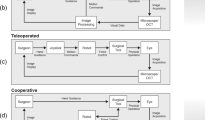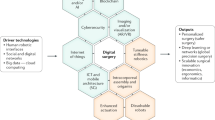Abstract
The rapid expansion of the field of minimally invasive surgery has been accompanied by a number of controversies. These novel surgical techniques offer benefits to the patient with regard to length of hospital stay, return to full activity, and cosmesis; also, they are often more cost-effective than open procedures. On the other hand, they are technically demanding, have a significant learning curve, and can be associated with high initial complication rates unless performed by experienced endoscopic surgeons. Telemedicine, which uses real-time video and information transfer, offers the potential to increase the availability of minimally invasive surgery through video-assisted surgery and through remote instruction. At present, remote communities, especially those within developed countries, can most immediately benefit from telesurgical approaches. Enthusiasm must be tempered by the issues of cost, security, surgeon liability and availability of the technology itself which have yet to be fully resolved. In this Review, the field of telemedicine, focusing specifically on telementoring and telesurgery, and its relevance to urology are discussed. From early experimental work to current clinical usage, the advantages of and problems in this evolving field are explored.
Key Points
-
Telemedicine has the potential to make a significant impact on urologic surgery and medicine in general
-
International telementoring has already been used successfully for urologic surgery
-
Telemedicine has not been taken up as quickly as predicted, despite initial enthusiasm, because of financial, technical and ethical issues
-
Telesurgery has yet to fully overcome the problems of security, liability and the potential issue of confidentiality
-
The formation of an international committee that would address these issues and coordinate global telemedical activity might aid further progress in this field
This is a preview of subscription content, access via your institution
Access options
Subscribe to this journal
Receive 12 print issues and online access
$209.00 per year
only $17.42 per issue
Buy this article
- Purchase on Springer Link
- Instant access to full article PDF
Prices may be subject to local taxes which are calculated during checkout


Similar content being viewed by others
References
Fabrizio MD et al. (2000) Effect of time delay on surgical performance during telesurgical manipulation. J Endourol 14: 133–138
Rosser JC Jr et al. (1999) Use of mobile low-bandwidth telemedical techniques for extreme telemedicine applications. J Am Coll Surg 189: 397–404
Marescaux J et al. (2001) Transatlantic robot-assisted telesurgery. Nature 413: 379–380
Cubano M et al. (1999) Long distance telementoring. A novel tool for laparoscopy aboard the USS Abraham Lincoln. Surg Endosc 13: 673–678
Moore RG et al. (1996) Telementoring of laparoscopic procedures: initial clinical experience. Surg Endosc 10: 107–110
Rosser J Jr et al. (1997) Telementoring: pushing the telemedicine envelope. J Assoc Acad Minor Phys 8: 11–15
Micali S et al. (2000) Feasibility of telementoring between Baltimore (USA) and Rome (Italy): the first five cases. J Endourol 14: 493–496
Challacombe B et al. (2005) Telementoring facilitates independent hand-assisted laparoscopic living donor nephrectomy. Transplant Proc 37: 613–616
Schulam PG et al. (1997) Telesurgical mentoring. Initial clinical experience. Surg Endosc 11: 1001–1005
Lee BR et al. (1998) International surgical telementoring: our initial experience. Stud Health Technol Inform 50: 41–47
Rodrigues Netto N Jr et al. (2003) Telementoring between Brazil and the United States: initial experience. J Endourol 17: 217–220
Bove P et al. (2003) Is telesurgery a new reality? Our experience with laparoscopic and percutaneous procedures. J Endourol 17: 137–142
Rovetta A and Sala R (1995) Execution of robot-assisted biopsies within the clinical context. J Image Guid Surg 1: 280–287
Jensen JF and Hill JW (1996) Advanced telepresence surgery system development. Stud Health Technol Inform 29: 107–117
Satava RM (1997) Virtual reality and telepresence for military medicine. Ann Acad Med Singapore 26: 118–120
Xvivo Robotic Animations [http://www.xvivo.net]
Challacombe BJ et al. (2003) Trans-oceanic telerobotic surgery. BJU Int 92: 678–680
Challacombe B et al. (2005) A randomized controlled trial of human versus robotic and telerobotic access to the kidney as the first step in percutaneous nephrolithotomy. Comput Aided Surg 10: 165–171
Sebajang H et al. (2006) The role of telementoring and telerobotic assistance in the provision of laparoscopic colorectal surgery in rural areas. Surg Endosc [doi: 10.1007/s00464-005-0260-0]
American Telemedicine Association [http://www.atmeda.org]
Flynn E (2005) Telesurgery in the United States. [http://www.homelanddefensejournal.com/pdfs/Medical_Stories/ Telesurgery_June05.pdf] (accessed 8 September 2006)
Satava RM (2004) Future trends in the design and application of surgical robots. Semin Laparosc Surg 11: 129–135
Swanstrom LL et al. (2005) Development of a new access device for transgastric surgery. J Gastrointest Surg 9: 1129–1136
Author information
Authors and Affiliations
Corresponding author
Ethics declarations
Competing interests
The authors declare no competing financial interests.
Rights and permissions
About this article
Cite this article
Challacombe, B., Kavoussi, L., Patriciu, A. et al. Technology Insight: telementoring and telesurgery in urology. Nat Rev Urol 3, 611–617 (2006). https://doi.org/10.1038/ncpuro0626
Received:
Accepted:
Issue Date:
DOI: https://doi.org/10.1038/ncpuro0626
This article is cited by
-
Integration of aquablation through telemetry: an alternative to onsite proctoring?
World Journal of Urology (2021)
-
Telemedizin im urologischen Setting
Uro-News (2019)
-
Telementoring: an Overview and Our Preliminary Experience in the Setting Up of a Cost-effective Telementoring Facility
Indian Journal of Surgery (2016)
-
Surgery in space: the future of robotic telesurgery
Surgical Endoscopy (2011)



